
Ambrosia dumosa, the burro-weed or white bursage, a North American species of plants in the family Asteraceae. It is a common constituent of the creosote-bush scrub community throughout the Mojave desert of California, Nevada, and Utah and the Sonoran Desert of Arizona and northwestern Mexico.

Arctostaphylos auriculata is an endangered species of Arctostaphylos endemic to California, and limited in geography to the area surrounding Mount Diablo, in Contra Costa County.

Githopsis specularioides is a flowering plant known by the common name common bluecup. It is an annual herb which bears very small tubular flowers with white throats and five pointed purple petals. It is found on the west coast of North America from California to British Columbia.

Githopsis is a small genus of flowering plants in the bellflower family which are known as bluecups. These are small annual wildflowers with white or purple white-throated blooms. Bluecups are native to western North America, especially California. There are four known species within the genus.

Allium haematochiton is a North American species of wild onion known by the common name redskin onion. It is native to northern Baja California, Sonora, and southern California as far north as Kern County. It grows on the slopes of the hills and mountains, such as those of the Peninsular Ranges, Transverse Ranges, and southern California Coast Ranges.

Allium amplectens, the narrowleaf onion, is a species of flowering plant. It is a onion native to the west coast of the United States, in Oregon, Washington State and California, also British Columbia in Canada. It grows in woods and especially in clay and serpentine soils.
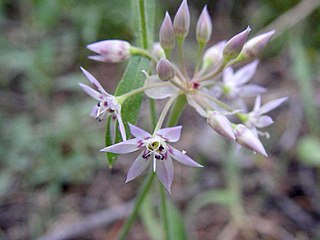
Allium campanulatum is a species of wild onion known by the common name dusky onion or Sierra onion. This is a flowering plant native to the western United States from southeastern Washington and northern Oregon to southern California, and western Nevada. The dusky onion grows in foothills and mountains, especially in dry areas, such as chaparral habitats.

Galium multiflorum is a species of flowering plant in the coffee family known by the common names Kellogg's bedstraw, shrubby bedstraw, and many-flowered bedstraw. It is a perennial herb that grows on rocky soils, mountains, and desert slopes.
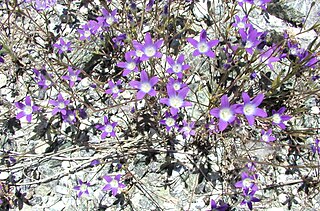
Githopsis pulchella is a species of flowering plant in the bellflower family known by the common names Sierra bluecup and largeflower bluecup. It is endemic to California, where it grows in the lower elevations of the Sierra Nevada and in the southern reaches of the Cascade Range.
Gratiola ebracteata is a species of flowering plant known by the common name bractless hedgehyssop. It is native to western North America from British Columbia to Montana to California. It grows in mud. This is a small, hairless, glandular annual plant rarely exceeding 10 centimeters in height. It grows from the mud of wet habitats, producing an erect stem in shades of reddish green. There are a few small red-bordered green leaves along the stem. The inflorescence is an extension of the stem a few millimeters long and coated in hairlike glands. The centimeter-long flower is a sort of rectangular tube which is yellowish or off-white. The fruit is a spherical capsule a few millimeters wide.

Hastingsia alba is a species of flowering plant known by the common names white rushlily and white schoenolirion.

Hastingsia serpentinicola is a species of flowering plant known by the common name Klamath rushlily. It is native to the mountains of northwestern California and southwestern Oregon, where it grows in serpentine soils.
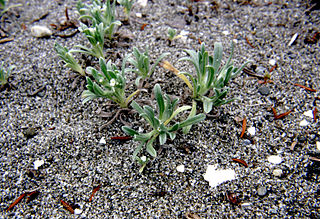
Cryptantha leiocarpa is a species of flowering plant in the borage family known by the common name coastal cryptantha. It is native to the coastline of Oregon and California where it grows in sandy areas such as beaches.
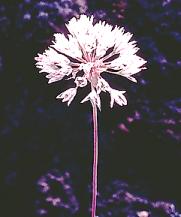
Allium jepsonii is a species of wild onion known by the common name Jepson's onion, honoring renowned California botanist Willis Linn Jepson.
Chorizanthe diffusa is a species of flowering plant in the buckwheat family known by the common name diffuse spineflower. It is endemic to California, where it grows on the coastline and mountains of the Central Coast, in sandy scrub, woodland, and forest habitat. It is erect to prostrate in form, its stem generally no longer than 15 or 20 centimeters. The leaves are up to 2 centimeters long and mainly arranged about the base of the plant. The inflorescence is a cluster of flowers, each surrounded by six hook-tipped bracts. The margins of the bracts proximal to the long hooked tip may be very thin and nearly invisible to wide and obvious, and they may be green to white to purplish. The flower itself is about 3 millimeters wide and white with a yellow throat. The tips of its tepals may be smooth or jagged or toothed.
Hackelia setosa is a species of flowering plant in the borage family known by the common name bristly stickseed. It is native to the Klamath Mountains of northern California and southern Oregon, United States, and it is also known from Sierra Valley to the southeast of that range.
Montia diffusa is a species of flowering plant in the family Montiaceae known by the common names branching montia and spreading miner's lettuce native to North America.

Phlox diffusa is a species of phlox known by the common name spreading phlox. It is native to western North America from British Columbia to the southwestern United States to the Dakotas, where it grows in many types of habitat, including rocky, high elevation mountain slopes. It is a very compact mat-forming perennial herb growing in cushions or patches of short, decumbent stems. The linear, lance-shaped, or needle-like leaves are no more than 1.5 centimeters long and are oppositely arranged in bundles on the short stems. The inflorescence is a solitary tubular flower around a centimeter long. It has a flat white or pale pink or blue corolla with five lobes each just under a centimeter in length.
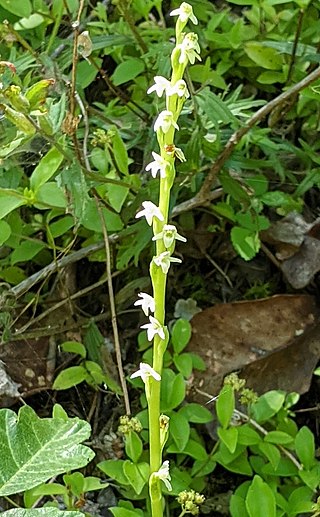
Platanthera ephemerantha is a species of orchid known by the common names whiteflower rein orchid, slender white piperia, and white-flowered piperia. It is native to western North America from Alaska to the San Francisco Bay Area, where it grows in coniferous forests and other habitat in coastal and inland mountain ranges within 150 kilometers of the coast. It grows erect to about half a meter in maximum height from a bulbous caudex. The basal leaves are up to 18 centimeters long by 3 wide. Leaves higher on the stem are much reduced. The upper part of the stem is a spikelike inflorescence of up to 100 small flowers, mostly arranged along one side of the stem. The fragrant, honey-scented flowers are whiter than those of other Platanthera, but sometimes green-tinged or -veined, or green with white margins. The status of this species in the wild is difficult to determine because most populations are small and may produce flowers only rarely.

Psilocarphus brevissimus is a species of flowering plant in the family Asteraceae known by the common names short woollyheads, woolly marbles, and woolly heads.
















